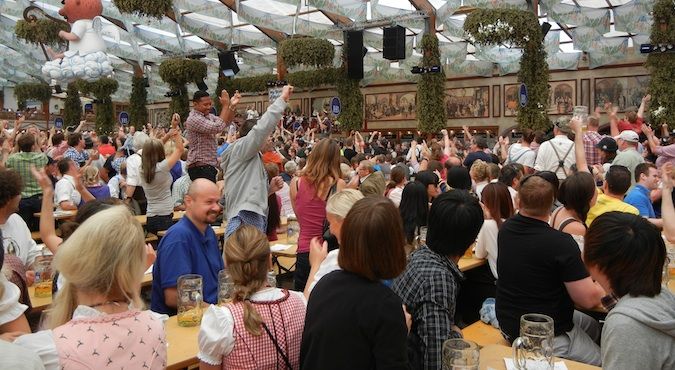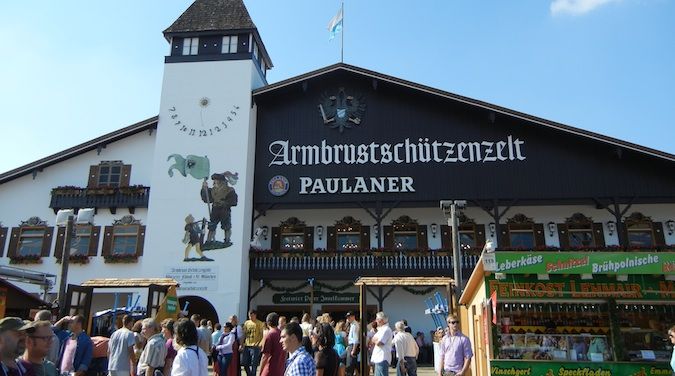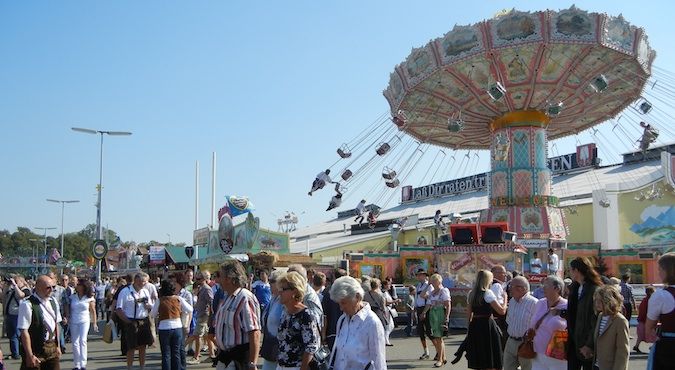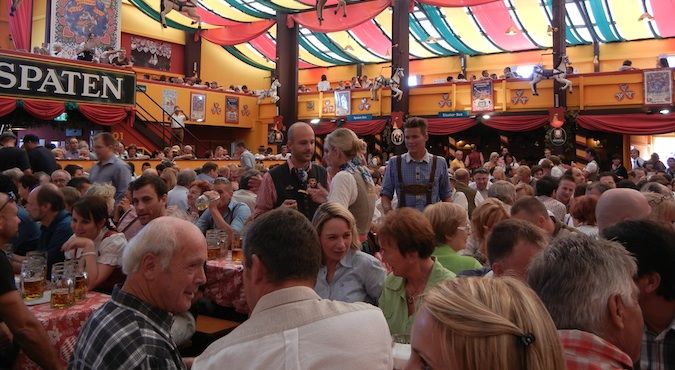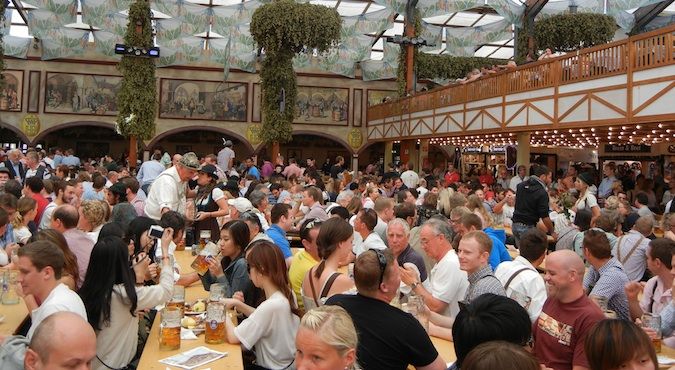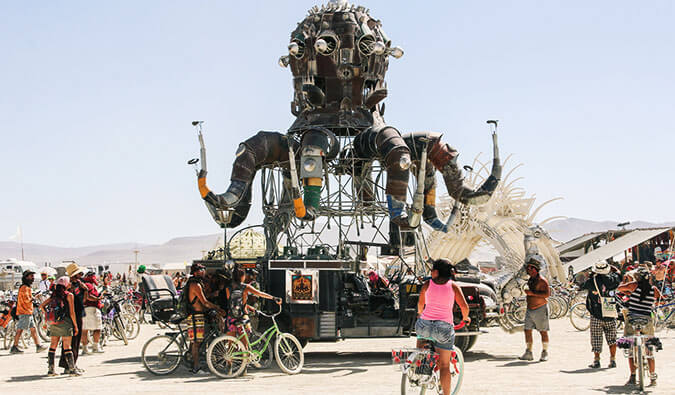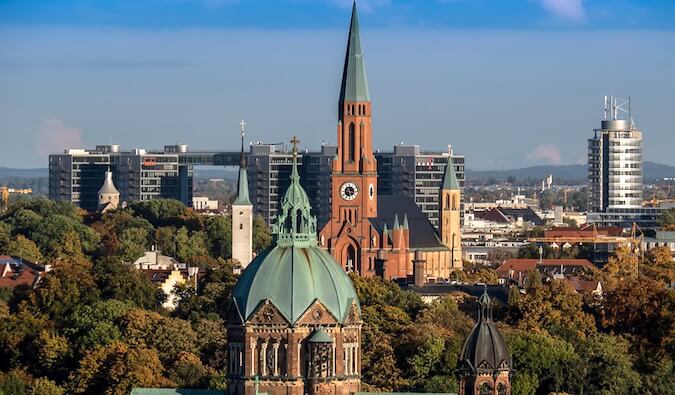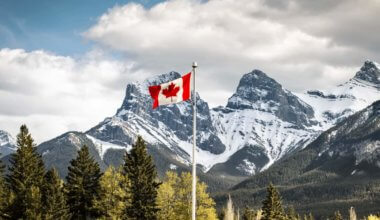How to Survive Oktoberfest
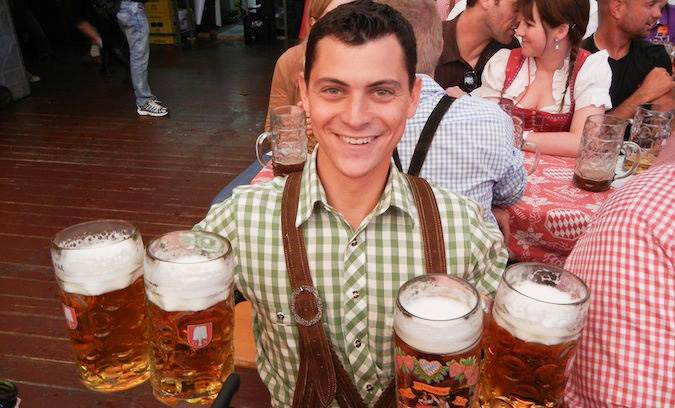
“How many days are you at the Wiesn (Oktoberfest) for?” the German girl wearing her traditional Bavarian dirndl across the table asked me.
“We’re here for five days,” I replied, putting down my umpteenth stein of beer.
Her face became a mix of shock, disbelief, and horror.
“Five days! That is crazy! You’re a bit insane, huh?” she said. “You only need one day for the Wiesen. I hope you survive.”
It turned out she was right. My friends and I were a bit insane to think five days wasn’t that long at Oktoberfest. We quickly learned that most Germans come for a day because that really is enough time at the Wiesn (the German name for Oktoberfest).
It’s the tourists who stay longer.
Five days at Oktoberfest was something I wouldn’t do again. In fact, I’m not sure I could do it again. It was overkill. Even the group I was with, filled with able-bodied, hardened drinkers, was exhausted by day three and uninterested by day five.
By the end, I never wanted to see a beer again.
But I survived the experience — and in the process had a great time, made a lot of new friends, hardened my liver, met some other cool travel bloggers, and learned just how to plan the perfect Oktoberfest trip.
In this post, I’ll walk you through everything you need to know about planning a trip to Oktoberfest.
Planning Your Oktoberfest Visit
What is Oktoberfest?
Oktoberfest was one of the best festivals I’ve ever attended. It’s a 16–18-day beer festival held annually in Munich, Germany, running from late September to the first weekend in October.
It all began when Crown Prince Ludwig married Princess Therese on October 12, 1810. The citizens of Munich were invited to attend the festivities held on the fields in front of the city, which the locals call “Wies’n” (which means grass, and why Oktoberfest is nicknamed Wiesn in Germany). Ever since then, it has become a major event, especially in the last few decades as more and more international travelers have been attracted to the festival thanks to tours, cheap flights, and better accommodation options.
It’s such a big thing that you’ll find Oktoberfest activities in cities around the world (though nothing beats the original).
What to Expect at Oktoberfest
Oktoberfest is a wild, no-holds-barred drinking festival. An estimated 7 million people visit every year, with the majority of those Germans (they represent 85% of attendees)! You’ll see just about everyone dressed up in traditional Bavarian clothes (lederhosen for guys, dirndls for girls), having a good time, and drinking lots and lots of beer. These pictures and video will help paint the scene for you:
You get a lot of people chugging beer….
….and a lot of people who fail at it….
….but no matter what, there’s a lot of singing.
Outside the beer tents, you’ll find a carnival atmosphere. Literally. The grounds contain a carnival with games, rides, and even haunted houses. It is like a theme park in Anywhere, USA. If it wasn’t for people dressed up, you wouldn’t have known you were in Germany. (This is also where you’ll find everyone passed out from too much beer!)
Inside the tents is where you find the traditional Oktoberfest you’ve come for: lots of hearty food, traditional music, large decorated tents, friendly people, large steins of beer, and a communal happy atmosphere that breeds friendship and joy! Everyone is here for a good time and in high spirits!
How Much Does Oktoberfest Cost?
All the tents are free to enter. Beer is typically around 12-13 EUR and most full meals are 12–20 EUR. Some tents offer lunch specials for 10-15 EUR and you’ll find tons of stands everywhere with sausage and wurst for 5-6 EUR too.
Reserving a table is technically free, however, a reservation requires you to order food and drinks. Usually, this is the equivalent of 2 beers and half a chicken (which is around 30-35 EUR per person). So a table for 10 will be around 300 EUR, depending on the tent.
It’s virtually impossible to do this event on a tight budget. You can buy beer or food outside the event grounds, which will lower your costs (get drunk and full before) but if you’re purchasing anything in the tents, expect to pay!
How to Make Table Reservations at Oktoberfest
All the tents are free throughout the day and all have free tables as well as reserved tables for people eating meals (these are also prime seats in the center of the tent). If you want to eat or guarantee a table (and not fight for all the free tables), you’ll need to make a reservation. We had a table reservation every day because my friends and I wanted to make sure we had a place to sit.
To make a reservation you’ll need to contact the tent directly via email, phone, or fax (yes, they still accept faxes!). This is typically done at the start of the year between January and April. The tables at the best tents fill up quickly and reservations for each tent don’t open at the same time (they are all managed separately).
If you do book at one of the tents, be aware that most tables seat 8-10 people and cost about 300-400 EUR (about 30-40 EUR per person). You’re required to book a whole table, so even if it’s just one of you going, you reserve the table as though you are going to fill it. While you’re supposed to have a full table when you sit down, we showed up minus a few people and they didn’t seem to care. This reservation includes some beer and food.
Personally, I’m not so sure I’d reserve tables again. It’s nice to know you have a place to sit down, but other than on weekends or at night, it seemed like you could always find an open seat, even if you had to stand for a while. If I booked a table again, I would only do it for the nighttime hours, when tables are harder to get, you’ll want a place to eat, and you might not want to stand around waiting. If you’re going solo or with a friend, you don’t need to book one. I’d only book if you have a big group.
Keep in mind that weekends, when the Germans aren’t working, are incredibly busy and it’s much harder to get a reservation as well as find free tables. If you don’t have a reservation, get there early!
A List of the Best Oktoberfest Tents
There are 17 main tents at Oktoberfest (and over 20 smaller ones) and each one has its own personality. Some tend to be heavy on Americans, others Australians, others older Germans, others rich celebrities. Here’s a look at the some of the major tents:
- Marstall – This tent holds over 3,400 people. It’s a bit more modern and inventive (you can actually get vegetarian and vegan food here) and caters to a younger, hipper crowd.
- Armbrustschützen-Festhalle – This comfortable tent has also been home to a crossbow competition since 1895. It’s one of the most popular, with room for almost 6,000 people inside!
- Hofbräu Festzelt – This is the most popular tent for international visitors, especially Americans, and is one of the biggest and most famous tents in the faregrounds. It gets busy but I loved it!
- Hacker-Festhalle – This tent is known for it’s painted blue sky and white clouds on the ceiling that can, if the weather is nice, open up to actually show the blue sky above. It’s also one of the more popular tents.
- Schottenhamel – This is the oldest tent at Oktoberfest and hasthe capacity for over 6,000 people. It’s where the party gets started and is very popular with Germans.
- Paulaner Festzelt – This massive tent is the largest at Oktoberfest with room for over 8,000 partygoers. You’ll be able to recognize it by the giant rotating beer glass.
- Schützen-Festzelt – This tent is located off the main drag which means you can sometimes beat the crowds by heading here.
- Käfer’s Wies’n-Schänke – This tent is known to be a favorite of both local and international celebrities as well as their late night ending time! Lots of people finish their night here.
- Fischer Vroni – If you’re tired of all the pork (the main dish in most tents) then head here for something else: fish!
- Ochsenbraterei – This tent has been around since 1881 and is known for its numerous ox dishes and its big brass band.
- Augustiner-Festhalle – This tent is considered to be the most family-friendly option. It’s also the hardest tent to get a table at as many locals have reserved seats here.
- Pschorr-Bräurosl – The Heide family has been running this tent since 1901 and has their own yodeler.
- Löwenbräu-Festhalle – This tent, which has a giant 15-foot lion at the entrance, has a bit more of an older crowd to it. It’s the favorite of local football players.
- Weinzelt – This tent is another more family-friendly choice, with less traditional offerings like seafood, Thai food, and even wine (something you don’t really see often here).
- Tradition – Yet another family-friendly tent, Tradition is the biggest tent on the Oide Wiesn and emphasizes — you guessed it — a more traditional experience. It’s less colorful but more cozy.
Where to Stay at Oktoberfest
Book your Oktoberfest room early. Accommodation fills up incredibly quickly — and some hotels and hostels book out up to a year in advance. The closer you get to the festival grounds, the more expensive beds are and the quicker everything fills up. I booked a room in April and most places were already sold out. That room cost me 120 EUR per night, but it was close to the festival grounds.
There’s not a lot of budget accommodation around but there are a few options if you don’t want to splurge on a hotel:
- The Tent – A youth hostel (well, really, a massive tent) outside the city for 20 EUR per night for a dorm, 10 EUR for a sleeping mat on the floor, and 40 EUR for a private tent.
- Wombats City Hostel – This is one of Munichs best (and most popular) hostels and it’s just a 15-minute walk to the festival.
- Couchsurf – While it’s free, it’s also difficult because locals get a lot of requests or have friends you can stay with. With that in mind, be sure to send requests early.
- Airbnb – If hostels aren’t your thing, check Airbnb. Prices will be high but if you book early you can likely snag the most affordable options.
How to Get Your Traditional Oktoberfest Outfit
You can’t go to Oktoberfest without the traditional Bavarian outfit (it just wouldn’t be right or as fun), and those are not cheap. A good lederhosen outfit begins at around 140-175 EUR. Dirndls, the traditional outfit for girls, begin at 100 EUR. (You can, of course, find cheaper outfits, though, if you aren’t looking for something of quality.)
You can order them online before you go or find them in stores throughout the city. Stores just selling outfits spring up just for the festival. We found lederhosen the day we arrived. You can rent costumes for around 45-60 EUR per day but that’s only a good option if you are going for a day or two. If you’re going for longer, it’s cheaper to buy an outfit.
General Oktoberfest Survival Tips
It’s a marathon, not a sprint — you’ll be drinking all day, so there’s no need to rush it. Too many people pass out on the lawns by dinnertime. Pace yourself. Those liters of beer are strong.
1. Hydrate: Drink a lot of water while you’re there. I had Powerade and water bottles lined up in my room for when I got home and when I woke up.
2. Get to the Käfer tent early: Most of the tents close at 10:30pm. Käfer is the only one open until 1am, so everyone rushes there after the others shut down. Get there a bit before 10:30pm so you have a spot. Otherwise, you simply won’t be able to get in or get served.
3. Get a table early: No reservation? Just winging it? If you aren’t there by midday, your chances of finding a table shrink greatly. Try to avoid the times when they switch reservations. All the people that got kicked out are now looking for a free table, and competition is fierce.
4. Eat outside the event area: While all the tents have amazing rotisserie chicken, the food inside is simply expensive. Just walk outside, buy a cheap sausage for a few euros, and save your money for the overpriced liters of beer.
5. Set a meet-up point: The grounds are huge. If you’re there with friends, set a meeting point in case you get separated (which is inevitable).
6. The tents don’t really matter: While everyone tent will offer a unique experience, the differences won’t be that drastic. Every tent will offer up a great time, so there’s no need to be picky. Find a tent you like and just stay there!
7. Bring cash: Keep your life (and the life of your server) simple and just stick to cash.
8. Keep your stuff safe: Pickpockets aren’t too much of a problem but you might get drunk and lose stuff. Only bring the essentials of what you need and be sure to keep them safe in a zipped pouch so they don’t get wet and ruined!
For maps of the event, news, updates, and other importan information, download the Oktoberfest app.
How to Visit Oktoberfest
After being canceled for COVID in 2020 and 2021, Oktoberfest is back.
Getting to Munich is easy as it’s accessible by rail from all major points in Europe and has its own international airport.
Oktoberfest takes place on Theresienwiese. It’s walkable from the main railway station (Hauptbahnhof) and the closest U-Bahn is, aptly called, Theresienwiese. Just follow the mass of crowds to the grounds. You can’t miss it!
Oktoberfest only happens once a year, and though it sort of busted my European budget, I don’t regret any of the money I spent. I’m really glad after years of false starts that I finally got to visit and celebrate Oktoberfest. My friends and I are already considering returning next year (though maybe not for five days again).
Get Your In-Depth Budget Guide to Europe!
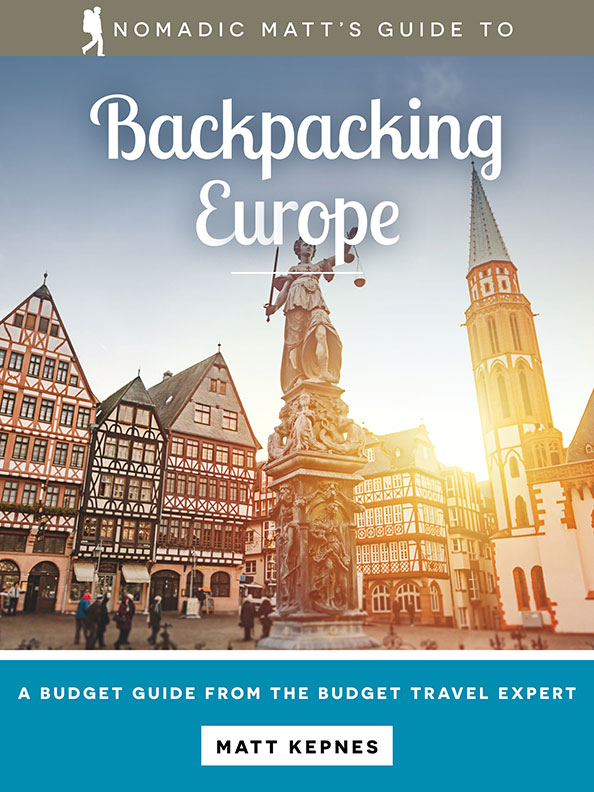
My detailed 200+ page guidebook is made for budget travelers like you! It cuts out the fluff found in other guides and gets straight to the practical information you need to travel while in Europe. It has suggested itineraries, budgets, ways to save money, on and off the beaten path things to see and do, non-touristy restaurants, markets, bars, safety tips, and much more! Click here to learn more and get your copy today.
Book Your Trip to Munich: Logistical Tips and Tricks
Book Your Flight
Use Skyscanner to find a cheap flight. They are my favorite search engine because they search websites and airlines around the globe so you always know no stone is left unturned!
Book Your Accommodation
You can book your hostel with Hostelworld as they have the biggest inventory and best deals. If you want to stay somewhere other than a hostel, use Booking.com as they consistently return the cheapest rates for guesthouses and cheap hotels.
Don’t Forget Travel Insurance
Travel insurance will protect you against illness, injury, theft, and cancellations. It’s comprehensive protection in case anything goes wrong. I never go on a trip without it as I’ve had to use it many times in the past. My favorite companies that offer the best service and value are:
- Safety Wing (for everyone below 70)
- Insure My Trip (for those over 70)
- Medjet (for additional repatriation coverage)
Looking for the Best Companies to Save Money With?
Check out my resource page for the best companies to use when you travel. I list all the ones I use to save money when I’m on the road. They will save you money when you travel too.
Need a Guide?
Fat Tire Tours offers fun and insightful bike tours around the city. You’ll see all the main sights with the help of a local guide and you’ll get to see the city in a whole new light. They’re a great alternative to your standard walking tour.
Want More Information on Munich?
Be sure to visit our robust destination guide on Munich for even more planning tips!

